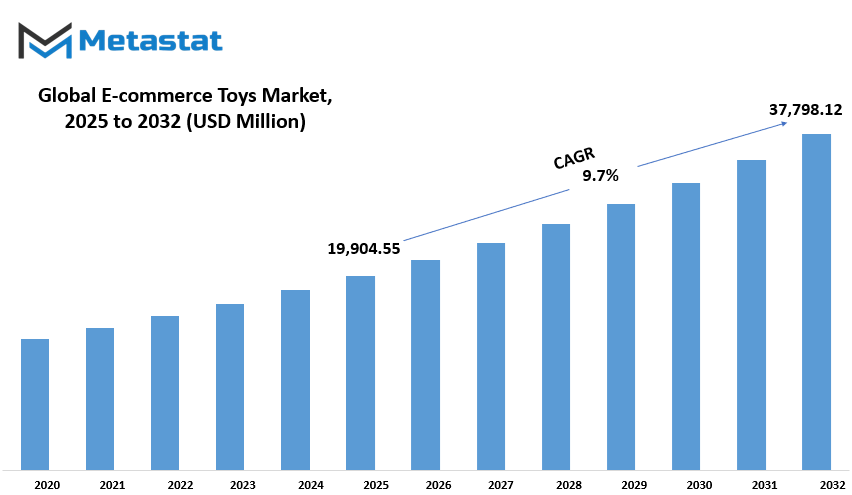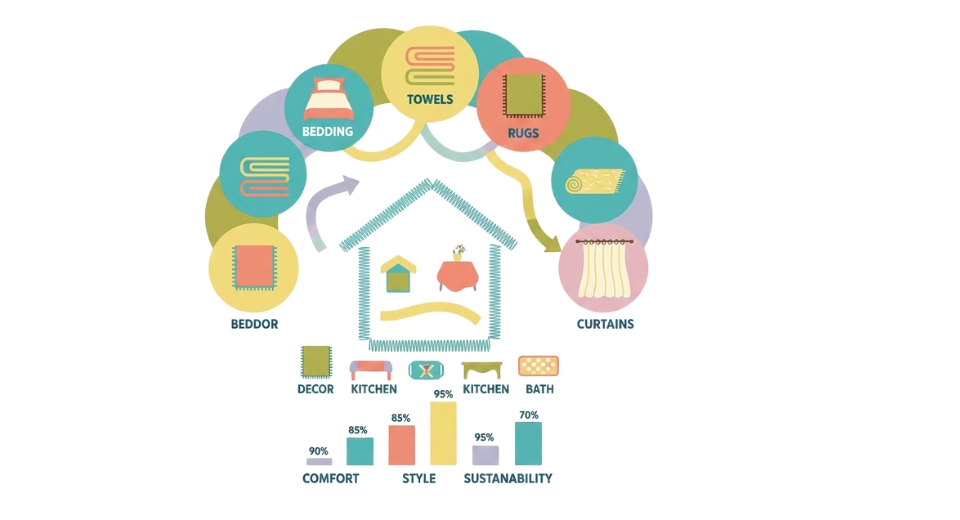MARKET OVERVIEW
The Global E-commerce Toys market is at the crossroads of digital retail and children's play, creating a dynamic market that will continuously re-imagine the way toys arrive in homes globally. As web platforms continue to expand their scope, this industry will undergo drastic changes, taking the business of supply and delivery far beyond what is traditionally imagined. With every subsequent year, the behavior of consumers will move more firmly in the direction of virtual shops, motivated not by simple convenience but by a wider digital environment that will combine personalized shopping, real-time feedback, and interactive online experiences.
In the future, the Global E-commerce Toys market will not be just about the trading of products. Rather, it will become an advanced network in which data analytics, consumer interaction, and brand loyalty become ever-more core features. As artificial intelligence and machine learning continue to advance, online toy stores will make their ability to predict trends and tailor product offerings to an extent that was unimaginable ten years ago even more precise. Customization will most likely extend to interactive product demonstrations, with virtual and augmented reality becoming a more prominent force in demonstrating toys to potential consumers prior to purchasing decisions.
Together, the regulatory environment will redefine itself to address the evolving challenges. Data privacy, particularly among younger users, will call for tighter compliance practices, both on the small business level and on the scale of larger industry players. Firms in the Global E-commerce Toys market will need to invest in open data-handling practices if they are to retain customer confidence and prevent reputational losses.
In addition, sustainability will move from being a niche issue to become a core business pillar. Shoppers will demand more environmentally responsible brands that practice accountability in packaging and sourcing. Logistics will also change, with businesses finding innovative ways to square the circle of speedy delivery needs with green commitments. This will not only tackle ethical necessities but will also lead to new business models based on circular economies like toy rental and recycling schemes operated through e-commerce platforms.
A further key shift will arise from the international character of the market itself. As connectivity improves in developing countries, once-neglected markets will account for a serious share of total sales volume. This trend will offer challenges and opportunities alike, as firms adapt their strategies to varied cultural tastes and navigate intricate foreign logistics structures.
The emergence of social commerce will introduce another dimension. Influencers, peer ratings, and community-driven recommendations will drive buying decisions to a larger degree, demarcating marketing and sales. Sites that manage to bring these factors together into seamless shopping experiences will have a competitive advantage.
In short, though the Global E-commerce Toys market is already a significant industry in digital retail, its path is toward an even more complex and advanced future. Advances in technology, shifts in regulation, environmental pressures, and changing consumer habits will all come together to create an industry that will continue to innovate in order to remain relevant. Instead of just being a medium for product exchanges, the market will evolve into a multi-dimensional setting that transforms the way toys are found, tested, and played with around the world.
Global E-commerce Toys market is estimated to reach $37,798 Million by 2032; growing at a CAGR of 9.7% from 2025 to 2032.

GROWTH FACTORS
The global e-commerce toys market is developing at a rapid pace because of enhanced internet penetration and continued use of smartphones. Such conditions make it quite convenient for parents and other consumers to purchase toys online. Many individuals in the present time find it more convenient to sit at home and browse as well as buy toys instead of going to physical shops. The changing shopping pattern is further being boosted due to increasing demand for educational and STEM toys. Parents have more concern for their children's learning and development and view these kinds of toys as an aid. With so many digital platforms, a parent can therefore test several educational toys to select the right one based on the child's growth and curiosity.
Even with the growth, there remain various issues which the market confronts. Quality of products is one of the main issues. When consumers buy products online, the toys cannot be seen or tested. Without this kind of inspection, several questions arise. Poor experiences damage consumer trust and affect repeat sales. The second is the large amount of competition from online sellers. With such a large number of players, there are price wars. While this may look good for the buyers, it eats into sellers' profit margins and makes it hard for some to survive.
Despite these problems, there are great opportunities in store. The increasing popularity of personalized toys is building a new wave of demand. Consumers are seeking personalized, one-of-a-kind products that can be tailored to their child's interests, making each purchase special. Subscription-based toy boxes are another promising trend. These companies ship a variety of toys to customers' doors on a regular basis, providing convenience and diversity. This model is attractive to busy parents who enjoy receiving fresh and interesting toys without the drudgery of endless hunting.
In the years ahead, these new ideas are expected to create new market segments and yield robust growth possibilities. Although worries regarding quality and price wars will require close scrutiny, the future of the market appears bright as it evolves in response to new consumer demands and emerging shopping practices.
MARKET SEGMENTATION
By Type
The global e-commerce toy market continues to grow with the increasing number of consumers choosing online retailers for convenience, variety, down to reasonable prices. Parents, gift buyers, and collectors browse through hundreds of options with ease, right from their homes. This way of buying has greatly affected the selling and promotion of toys by toy companies. With the rapid increase in demand, new players are now keen to supply trendy and educational toys through digital platforms. It is one of the biggest categories in this area and has gained good attention with an increased focus on child learning and development at home. This one category alone represents $19,904.55 million, showing how much parents and caregivers are willing to invest in toys that educate children while helping them have fun.
Apart from Educational Toys, the e-commerce toy market would include Action Figures, Dolls, and Plush Toys, Puzzles and Board Games, Electronic Toys, and Outdoor and Sports Toys. These are a myriad of categories catering to age groups and interests so that buyers can very well shop for what suits them. Action figures are mostly popular with kids that love role-playing or keep track of characters in films or television shows. Dolls and cuddly toys remain forever young unto a real favorite for the little ones while giving comfort and stimulation for play. The games are highly favored during holidays when families tend to stay home for longer intervals. Electronic toys are also increasingly favored as they merge fun and technology. These can be toys like learning tablets or interactive robots. Outdoor toys and sports toys encourage exercise, which parents want to offset the amount of time spent on screen.
What makes online business best for toy selling is the way e-commerce can offer detailed product descriptions, product reviews, and even videos that help customers make an informed purchase. With the growth and phenomena-centric trend of convenience for small companies to enter a downsized market and be able to reach the global consumers, online stores will continue growing. Free shipping, discounting, and return and refund policies are aggravating the online purchase appeal due to lowered local purchase expenses from any store or retailer. Therefore, OEM brands and fresh sellers are set to pour in headlong into online stores and buyer experience upgrades. With the shift in consumer behavior and growing need for online purchases fueling the industry, the toys ecommerce market will keep expanding, offering increasingly more options and ease for every kind of consumer.
By Application
The worldwide e-commerce toy market keeps on expanding as a result of the convenience of buying products online and the extensive array of goods on offer to customers. One of the most critical methods of understanding this market is examining how it is applied, particularly in the application context. The market can be split into four primary sectors: learning and development, entertainment, skill improvement, and exercise. These types of toys explain the various functions toys serve in a child's development and daily life.
Learning and developmental toys are made with the purpose of enabling early learning. Parents prefer choosing these products in an attempt to expose their kids to basic things like numbers, letters, shapes, and color. These toys usually contain elements like sounds, lights, or movable components that facilitate learning. When kids engage in educational toys, they do not play without learning but instead create the grounds for further learning. This is a natural, fun process of learning by playing.
Play toys remain a large part of the market. These are mainly for entertainment and play purposes and are designed to keep children busy with their free time. From dolls and action figures to puzzles and games, these categories of toys provide children with an avenue through which to play and entertain themselves and use their imagination. Entertainment is the main intention here, but children will learn good lessons in sharing, storytelling, and socialization as a result of this kind of play.
Development of skills toys differ slightly because they are designed to assist children in developing certain abilities. These could be problem-solving, hand-eye coordination, or even memory formation. Examples include construction sets, brain games, or art and craft kits. While children go through these obstacles, they sharpen their concentration, patience, and thinking capacities. These abilities will serve them not only in school, but in everyday life too.
Lastly, toys that encourage physical activity are designed to keep kids active. These include items like ride-on toys, sports equipment, or outdoor play equipment. These toys are significant because they engage kids in physical activity and make them healthier. At the same time, they facilitate physical growth as well as help develop motor skills. Indoor toys or outdoor play toys, these are great ways to get kids to burn energy and have strong physical bodies.
In brief, the international e-commerce toys market is defined by how the toys are utilized. Each category contributes value in a unique manner, enabling children to develop while providing parents with numerous alternatives to facilitate their growth.
By Sales Channel
The global e-commerce toys market is emerging fast as consumers' shopping trends continue to lean towards digital mediums. Many gift purchasers and parents today prefer the ease of web browsing and placing orders for toys. This change has been part of the reason why there is an increase in the number of online sales channels, each following its own way of reaching the consumers. A notable channel is online shops. These are websites that specialize in selling toys only or have a large toy section in a larger online store. They are likely to offer a wide variety of products, fast delivery, and discounts that attract customers looking for convenience and variety.
Another key player is e-commerce websites. These are larger websites that have many sellers and brands all in one place. They offer buyers the chance to compare prices, read reviews, and access popular as well as rare toys. Sellers like the exposure these websites give them since many buyers begin their search here. These websites will usually have secure payment methods and buyer protection, which are good reasons why online buyers flock here.
Direct-to-consumer websites also shape the market. These are websites owned by companies where the company sells the toys directly to the consumers. It allows the brands to provide distinct products and control pricing, packaging, and customer experience. Many consumers purchase through these websites due to brand affinity, quality check, and frequent early access to new products. It also allows the companies to better understand the customer behavior as a result of direct consumer feedback and insights.
Third-party marketplaces are another indispensable sales channel. Platforms allow multiple independent sellers to offer their toys within a single shared environment. They can be small-scale toy stores with handcrafted items, or small businesses looking for an international market. The appeal of the channel is the variety of quirky and inexpensive items it offers. Consumers are fond of the variety and option to patronize the small sellers.
All of these channels are important in the online selling of toys. As the global market continues to expand, more than one mode of selling is being used by companies to reach different types of buyers. The focus will remain on making shopping easier, offering the best deals, and setting up a trust level with buyers. With advancement of technology and the change in consumers, selling toys online continues to adapt to meet the new requirements.
By End Users
The global E-commerce Toys market is growing very fast, and understanding its customers is the majority of how firms plan and survive. It classifies the market on the basis of age segments - Infants (0–3 Years), Children (3–12 Years), Teenagers (13–18 Years), and Adults. They each have their unique preferences and demand, which affect exactly what sort of toys truly are made and sold online.
For babies aged 0 to 3 years, simplicity and safety prevail. Parents and caregivers typically look for soft toys, learning devices, and vibrant objects that facilitate learning and development of infants. The products should be easy to hold, made from non-poisonous materials, and without sharp ends. Online stores typically prioritize these aspects to enable the parents to make rapid and dependable choices.
Kids in the age group of 3 to 12 make up the largest share of the E-commerce Toys market. They are typically drawn to toys that are interactive, puzzles, building sets, and character items from cartoons or films. Since children in this age group are developing and learning rapidly, toys are typically created to aid in motor skills, imagination, and problem-solving. These websites are mostly based on recommendations and filtering to guide the consumers to the right products, based on age, interest, or even style.
Teenagers, ranging from 13 to 18 years, mostly choose more interactive or pertinent toys to contemporary culture. These include advanced building kits, video games collections, or hobby toys like model collections and do-it-yourself crafts. A number of teenagers also like technology-based products, for example, drones or smart gadgets. Brands will need to highlight rich product descriptions, reviews, and a hip image in an attempt to capture their attention, as they are likely to do research and buy online on their own.
Notably, adults also represent an up-and-coming segment in the E-commerce Toys market. For de-stressing, hobbying, nostalgia, or collecting, adults increasingly purchase toys for themselves without concealment. Toys such as collectible figures, board games, or advanced puzzles are especially in demand. Online platforms enable this by way of special releases, extended product teasers, and safe shipping options.
In general, being aware of these numerous end users allows businesses to create better marketing, construct valuable features, and offer the right products for every user segment. With increasingly more individuals continuing to shop online, keeping an eye on these user segments will remain key to determining how toys are made and sold worldwide.
|
Forecast Period |
2025-2032 |
|
Market Size in 2025 |
$19,904.55 million |
|
Market Size by 2032 |
$37,798.12 Million |
|
Growth Rate from 2025 to 2032 |
9.7% |
|
Base Year |
2024 |
|
Regions Covered |
North America, Europe, Asia-Pacific, South America, Middle East & Africa |
REGIONAL ANALYSIS
Global E-commerce Toys market is distributed across a number of key regions, which further comprise a number of countries in their contribution towards the growth of the market. As we walk through the geography segmentation of the market, we have North America, Europe, Asia-Pacific, South America, and Middle East & Africa. These regions have also been sub-divided to see the contribution and performance of each region in the global market.
In North America, the market is divided into the United States, Canada, and Mexico. The U.S. dominates the region with its robust online buying infrastructure and high consumer expenditure. Canada and Mexico also contribute to market expansion but to a lesser extent than the U.S. In Europe, the UK, Germany, France, and Italy dominate the market, along with other European countries. These nations have been seeing consistent demand for toys through internet portals due to increasing use of the internet and increasing popularity of online shopping. Germany and the UK, in specific, are dominant forces in this region with numerous prominent toy brands and a vast customer base.
Asia-Pacific is a growth area in the future. India, China, Japan, South Korea, and all the other Asian-Pacific nations make up this portion of the market. India and China, through their vast numbers and increasing online access, will keep internet toy sales moving upward. Japan and South Korea also play a significant role through the technology and established e-commerce marketplaces of these nations. Because children here are spending increasingly more money on entertainment and child development, web demand for toys will continue to increase.
In South America, Brazil and Argentina are followed by the Rest of South America. Although the economy in this market fluctuates, there is obvious growth in the use of e-commerce, particularly in metropolitan cities. Last but not least, the Middle East & Africa comprise GCC Countries, Egypt, South Africa, and the Rest of the region. These regions have positive developments with better online penetration and heightened demand for global brands.
Overall, every region will have something that is unique and different, and knowing these geographic segments will enable companies to customize their strategy. The market is growing, and with more individuals having access to the internet globally, more families will opt to purchase toys online.

COMPETITIVE PLAYERS
The global e-commerce toys market is growing fast, and many established companies are finding it hard to match up. The industry has both international conglomerates and leading local brands which are revolutionizing online toy shopping. In Türkiye, some of the key players include Hepsiburada, Trendyol, Amazon Türkiye, n11, Ciceksepeti Internet Services Inc., Toypa Mağazacılık Tic. A.Ş., Teknosa, CarrefourSA, LC Waikiki, and Koçtaş. These companies are always aiming to improve customer experience by offering varied varieties of toys, easy navigation at their websites, and speedy delivery services. They want to make it easy and convenient for parents, gift-givers, and children to shop.
One of the causes of this expansion is growing smartphone and internet usage. More and more families are increasingly shopping from home, and they are searching for safe, entertaining, and educational toys for kids. E-commerce sites are reacting to this demand by offering complete product details, customer feedback, and regular promotions. This helps buyers compare and select what best fits their needs. Further, most online shopping sites offer filtering by age group, brand name, and category, so parents can make decisions faster.
Another aspect that is driving the growth of the market is increasing awareness among parents about toys supporting learning and development. The majority of the key players in Türkiye focus on selling educational toys that support thinking, creativity, and motor skills. They primarily stock top brands and popular licensed characters, which makes their products even more appealing to children. Having the capacity to keep up with trends and offer the latest products is part of the reason why these companies continue to grow.
In addition, safe payment options and open returns policy give customers confidence. Individuals would rather return to a page that gives them confidence in their transactions. The companies mentioned above have good customer care and trustable service, which they can leverage to get back customers. They also leverage social media pages and online advertisements to reach more people, especially during holidays when toy sales usually pick up.
As the customers increasingly turn to online shopping, the e-commerce toy market will continue to expand. With high competition among the major players, quality, convenience, and customer satisfaction will continue to be the focus. This will shape the future of toy sale and purchase in the digital age.
E-commerce Toys Market Key Segments:
By Type
- Educational Toys
- Action Figures
- Dolls and Plush Toys
- Puzzles and Board Games
- Electronic Toys
- Outdoor and Sports Toys
By Application
- Learning and Development
- Entertainment
- Skill Development
- Physical Activity
By Sales Channel
- Online Retailers
- E-commerce Platforms
- Direct-to-Consumer Websites
- Third-Party Marketplaces
By End Users
- Infants (0–3 Years)
- Kids (3–12 Years)
- Teenagers (13–18 Years)
- Adults
Key Global E-commerce Toys Industry Players
- Hepsiburada
- Trendyol
- Amazon Türkiye
- n11
- Ciceksepeti Internet Services Inc.
- Toypa Mağazacılık Tic. A.Ş.
- Teknosa
- CarrefourSA
- LC Waikiki
- Koçtaş
WHAT REPORT PROVIDES
- Full in-depth analysis of the parent Industry
- Important changes in market and its dynamics
- Segmentation details of the market
- Former, on-going, and projected market analysis in terms of volume and value
- Assessment of niche industry developments
- Market share analysis
- Key strategies of major players
- Emerging segments and regional growth potential








 US: +1 3023308252
US: +1 3023308252






